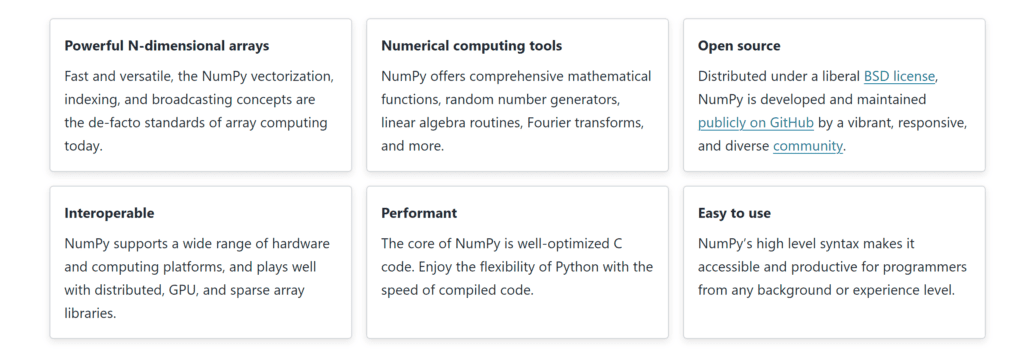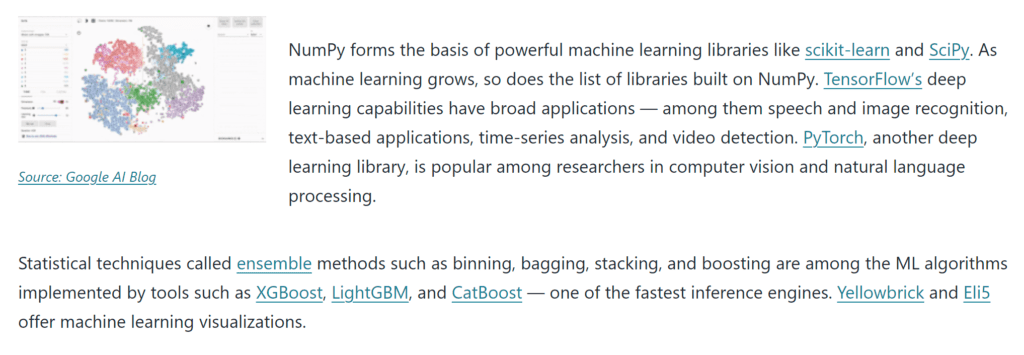Table Of Content
If you’re dealing with numerical data, NumPy is the library for you, thanks to its ability to perform complex mathematical operations and support for large multidimensional arrays and matrices.
What is NumPy
NumPy, standing for Numerical Python, is a core library for scientific computing in Python. It provides a high-performance multidimensional array object, and tools for working with these arrays.
How to Use NumPy
Using NumPy, you can perform a variety of operations with ease. You can create arrays filled with zeros, ones, or random values, and execute operations like sorting, concatenating, or reshaping arrays without needing to write loops in Python. This efficiency comes from NumPy’s operations being implemented in C, which makes them incredibly fast compared to standard Python sequences.

Pros
- Speed: NumPy operations are implemented in C and optimized for performance, making them much faster than standard Python.
- Versatility: Supports an extensive range of operations on arrays, from basic mathematical functions to complex linear algebra.
- Integration: Plays well with other libraries, forming the foundational array structure for other data science tools like SciPy, Pandas, and Matplotlib.
Cons
- Memory Usage: NumPy arrays require a continuous block of memory, which can be a drawback for very large datasets.
- Flexibility with Data Types: All elements in a NumPy array must be of the same type, which limits flexibility compared to native Python lists that can hold heterogeneous data.
Pricing
NumPy is an open-source library, which means it is free to use. You can easily integrate it into your projects without worrying about licensing fees, making it a cost-effective solution for scientific computing.

Use Cases
NumPy is widely used in various fields including data analysis, machine learning, engineering, and scientific research. It’s particularly useful for tasks that require efficient operations on large numerical datasets, such as:
- Image processing and computer vision.
- Simulation of scientific experiments.
- Statistical analysis and data modeling.
- Machine learning algorithms that require fast matrix operations
NumPy and AI
NumPy is a vital tool for artificial intelligence primarily because of its efficient handling of large, multidimensional arrays and matrices, which are ubiquitous in AI applications. Here’s how NumPy can be utilized in AI:
- Data Preprocessing: AI models require data to be in a specific format. NumPy is used extensively to transform raw data into a format suitable for machine learning models, such as converting images into numerical arrays or normalizing data sets.
- Feature Engineering: It can be used to compute features from data sets. Whether it’s adding new features, selecting specific features, or transforming them, it provides the computational backbone for these operations efficiently.
- Machine Learning Algorithms: Many machine learning algorithms, especially those that involve matrix multiplications or transformations (like in neural networks), rely on it for their underlying computation. For example, when implementing a basic version of gradient descent or other optimization algorithms in Python, NumPy’s functions are used to perform operations like additions, subtractions, and dot products on vectors and matrices efficiently.
- Deep Learning Frameworks: While NumPy itself is not used for training deep learning models at scale (due to the lack of hardware acceleration), it is foundational in the development of deep learning libraries like TensorFlow and PyTorch. These libraries use NumPy-like arrays for their basic data structures and often start as NumPy arrays before being converted into more specialized structures that can run on GPUs or TPUs.
- Simulation and Modeling: AI often requires the simulation of complex systems or the modeling of data. NumPy’s ability to handle large computational tasks quickly makes it an excellent tool for these purposes, facilitating rapid testing and iteration of models.

By supporting these core tasks with its robust, high-performance computing capabilities, NumPy serves as a cornerstone in the toolkit of any AI developer, allowing them to focus more on designing and tuning their models rather than worrying about the computational efficiency of their data structures.









Leave a Reply
You must be logged in to post a comment.